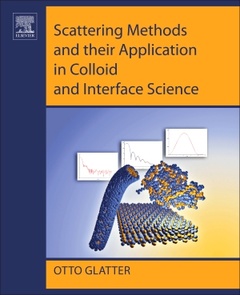Scattering Methods and their Application in Colloid and Interface Science
Auteur : Glatter Otto

Scattering Methods and their Application in Colloid and Interface Science offers an overview of small-angle X-ray and neutron scattering techniques (SAXS & SANS), as well as static and dynamic light scattering (SLS & DLS). These scattering techniques are central to the study of soft matter, such as colloidal dispersions and surfactant self-assembly. The theoretical concepts are followed by an overview of instrumentation and a detailed description of the evaluation techniques in the first part of the book. In the second part, several typical application examples are used to show the strength and limitations of these techniques.
1. Interference, Rayleigh-Debye-Gans Theory2. General Theorems and Special Cases3. The Inverse Scattering Problem4. Concentration Effects, Interactions5. Absolute Intensity6. Contrast Variation7. Instrumentation8. Numerical Methods9. Static Light Scattering from Small Particles10. Light Scattering from Large Particles – Lorenz-Mie Theory11. Dynamic Light Scattering
PART II12. Dilute Systems – Practical Aspects – Applications13. Concentrated, Interacting Systems – Practical Aspects – Applications14. Glasses, Liquid Crystals and Gels
(Post)-graduate students, young researchers and scientists in academia and industry using scattering techniques applied to colloid and interface science
During the last ten years he focused on the development of new, nano-structured materials with hierarchical organization. He published more than 170 papers in international scientific journals and was invited to more than 75 international conferences as plenary lecturer, keynote speaker of invited speaker. He organized two international conferences and four international workshops.
In 2012 he received the Guinier Prize 2012, Sydney, Australia; in 2013 the Overbeek Gold Medal 2013, ECIS, Limassol, Cyprus, and in 2016 the Lectureship Award of the Division of Colloid and Surface Chemistry of the Chemical Society of Japan. He is the editor of the book Small Angle X-ray Scattering (1982, Academic Press).
- Features the latest input from the world-leading expert with personal experience in all the fields covered (SAXS, SANS, SLS and DLS)
- Includes unified notation throughout the book to enhance its readability
- Provides—in a single source—scattering theory, evaluation of techniques and a variety of applications
Date de parution : 01-2018
Ouvrage de 404 p.
19x23.3 cm
Thèmes de Scattering Methods and their Application in Colloid and... :
Mots-clés :
Absolute scale; Aggregate; Aggregation; Anomalous scattering; Attractive interaction; Background; Bicontinuous systems; Block collimation; Calibration; Charged systems; Closure relations; Compressibility; Concentration effect; Contrast; Contrast matching; Contrast variation; Convolution square root; Correlation function; Cumulant analysis; Deconvolution; Dense emulsions; Desmearing; Detector; Differential scattering cross-section; Diffusion constant; Electrophoretic dynamic light scattering; Experimental set-up; Flowing media; Form factor; Fractals; Generalized indirect Fourier transformation; Glass transition; Hard-sphere systems; Homogeneous particles; Hydrodynamic radius; Hydrogels; Indirect Fourier transformation; Inhomogeneous particles; Instrumental broadening; Interacting systems; Interaction; Interference; Invariant; Label triangulation; Lamellar particle; Lamellar phases; Large impurities; Large particles; Liquid crystals; Lorenz-Mie theory; Model functions; Molecular mass; Molecular weight; Multiple scattering; Multispeckle method; Nanoparticles; Non-ergodic systems; Nonergodic systems; Nonlamellar liquid crystals; Pair-distance distribution function; Particle scale; Particle sizing; Pinhole camera; Polymer chains; Porod law; Power spectrum; Proteins; Radius of gyration; Rayleigh-Debye-Gans theory; Refractive index increment; Repulsive interaction; Rod-like particle; SANS instruments; SAXS instruments; Scattering length density; Second virial coefficient; Secondary standard; Selective deuteration; Self-assembling systems; Shape analysis; Single-mode fiber; Size distribution; Smoothing; Specific surface; Sphere; Structure factor; Surface; Time correlation function; Transfer kinetics; Volume; Zimm plot



